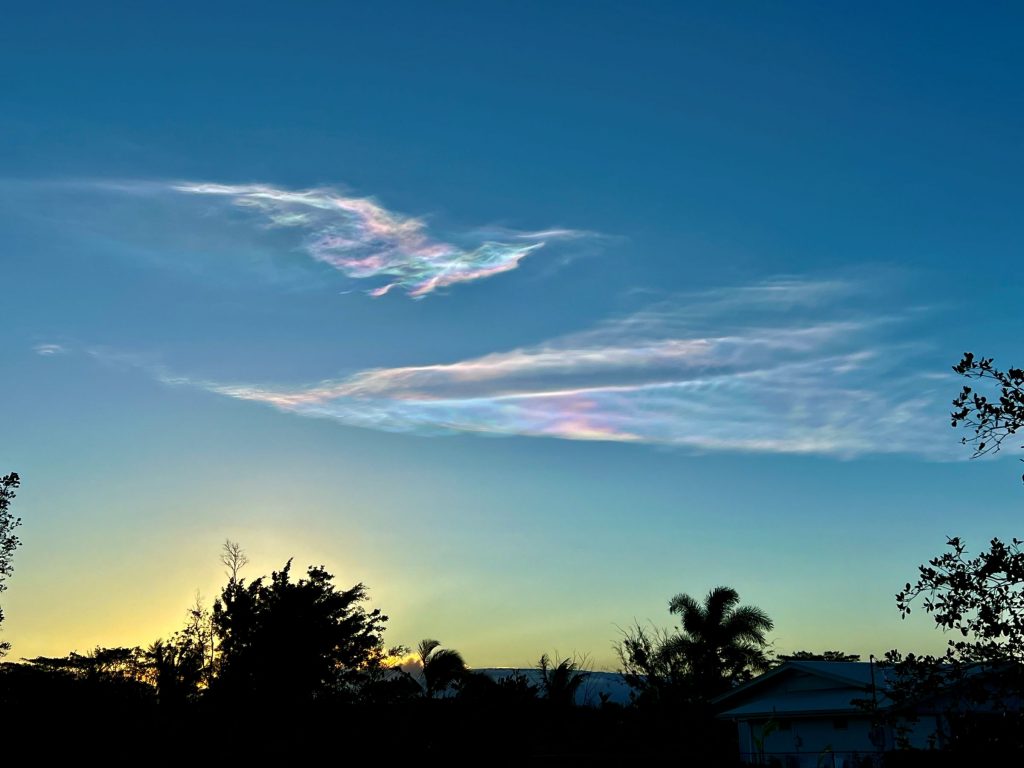Rare high-altitude ‘rainbow clouds’ make appearance over Big Island
Rainbows are apparently no longer confined to waterfalls and after rain on the Big Island. Now, they’ve been spotted floating in the sky.
East Hawai‘i was treated to a colorful show Tuesday evening as the sun set and into dusk with the appearance of rare wispy-like noctilucent clouds. The iridescent “rainbow clouds” thrilled and captivated those who saw them, in person and in photos on social media, hovering through the upper atmosphere.

“Looked like a psychedelic oil slick in the clouds,” commented Chris James of Nīnole on a post in the Puna Weather Facebook group with photos of the clouds attached.
George Dunham of Hawaiian Paradise Park replied: “The sky was trippin’.”
“Our own northern lights, Hawaiian style,” replied Karen Foster to photos of the clouds Dunham posted in the Hawai‘i Tracker Facebook group.
Dunham called it an “amazing ice crystal display!”
Several commenters said they’d never seen clouds like this before. The clouds even sparked a conversation about them Wednesday afternoon at the National Weather Service forecast office in Honolulu.
For good reason.
“We don’t have any particulars, but they aren’t especially common” in Hawai‘i,” said Maureen Ballard, a senior meteorologist at the Honolulu office.
First off, cloud iridescence in itself is relatively rare. It usually happens in altocumulus, cirrocumulus, lenticular and cirrus clouds. It’s caused by small water droplets or ice crystals scattering sunlight.
A cloud must be thin and have a lot of water droplets or ice crystals of about the same size to become a “rainbow cloud.” That’s why semi-transparent clouds or those just forming usually are the most likely to taste the rainbow.
Noctilucent clouds — the Earth’s highest clouds — also are usually only observed at high latitudes between 45 degrees and 80 degrees, well north of Hawai‘i which sits at about 20 degrees north, and during the summer months. They are only visible after sunset during astronomical twilight, when the sun is below the horizon but some sunlight continues to be scattered between air molecules.
Their high altitude allows them to reflect that last remaining sunlight from below as they fly across the horizon.

During the past two decades, the clouds — also known as polar mesospheric clouds because they form and occur in the Earth’s mesosphere, which spans from 47 to 53 miles above the surface — have started to become more bright and visible at lower latitudes.
According to the National Oceanic and Atmospheric Administration’s National Centers for Environmental Information, no noctilucent clouds were observed before 1885. A Phys.org article from July 2018 says the clouds were first observed that year after Krakatoa volcano in Indonesia erupted, ejecting massive amounts of water vapor into the atmosphere.
These night-shining clouds also are considered “harbingers of climate change,” resulting from increased methane in the atmosphere.
“Methane is a potent greenhouse gas that produces water vapor — a key ingredient of noctilucent clouds — through chemical reactions, namely oxidization within the troposphere by the hydroxyl radical (OH), according to the Environmental Change Institute at the University of Oxford,” states a Space.com article from Aug. 7, 2023.
Throughout the period from 1871-2008, a study published in July 2018 in the scientific journal Geophysical Research Letters found “methane emissions had more than doubled the amount of mesospheric ice present, thus increasing the likelihood of noctilucent cloud formation.”
Franz-Josef Lübken, an atmospheric scientist at the Leibniz Institute of Atmospheric Physics in Kühlungsborn, Germany, said in the Phys.org article that the clouds were likely only visible once every several decades or so in the 19th century.
Within the past couple of years, however, they’ve upped their game.
The Space.com article from last year said 2022 was a particularly good year for noctilucent cloud displays, which also can be seen from space. NASA’s Aeronomy of Ice in the Mesosphere mission, which focused on studying how these high-altitude rarities form, found the highest increase in their frequency in 15 years.
The Big Island’s colorful cloud encounter Tuesday evening was such a hit that people were still talking about it and posting photos Wednesday and even Thursday on social media.
“Last night was truly magical,” said Suzi M. Anderson in a post-Wednesday night in the Hilo, Hawai‘i, Facebook group that included a photo of one of the rare clouds she said looked like an eagle flying over the Target parking lot. “I greatly enjoyed seeing so many people lookin up in awe.”










